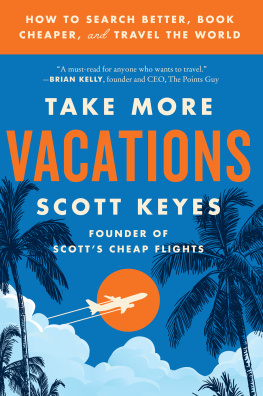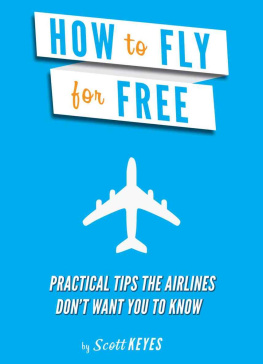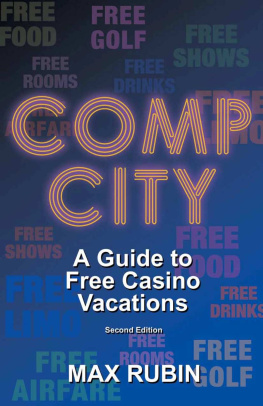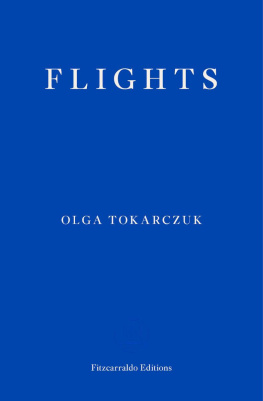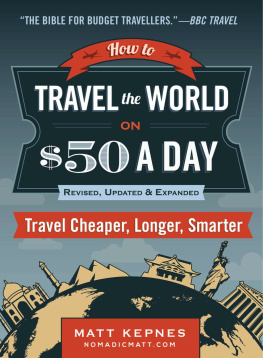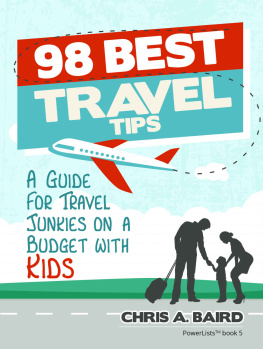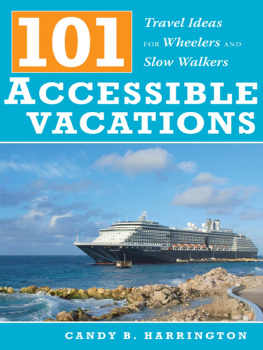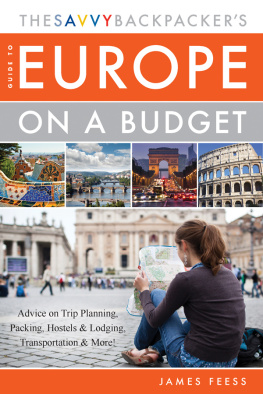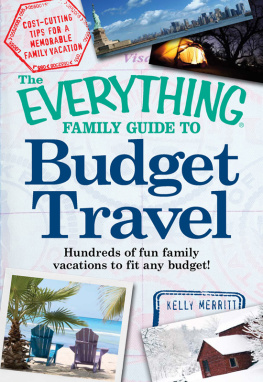Contents
Guide
Illustration adapted from blank map of Europe by Maix and Tintazul under CC BY-SA 3.0.
TAKE MORE VACATIONS . Copyright 2021 by Scotts Cheap Writes, LLC. All rights reserved under International and Pan-American Copyright Conventions. By payment of the required fees, you have been granted the nonexclusive, nontransferable right to access and read the text of this e-book on-screen. No part of this text may be reproduced, transmitted, downloaded, decompiled, reverse-engineered, or stored in or introduced into any information storage and retrieval system, in any form or by any means, whether electronic or mechanical, now known or hereafter invented, without the express written permission of HarperCollins e-books.
FIRST EDITION
Cover design by Joanne ONeill
Cover images bitontawan/iStock/Getty Images (plane); kbeis/Getty Images (clouds); la_puma/iStock/Getty Images (trees)
Digital Edition MAY 2021 ISBN: 978-0-06-299356-4
Version 03222021
Print ISBN: 978-0-06-299354-0
Contents
I N 2013, I FLEW NONSTOP FROM N EW Y ORK C ITY TO M ILAN on a flight that typically cost $850 roundtrip. I paid $130.
Id never considered visiting northern Italy until the moment those fares popped up. In fact, the only thing I knew about Milan was its reputation as a fashion hub. (And trust me, nobody has ever looked at my wardrobe and thought: Now thats a trendsetter.)
But at $130, the question was no longer Can I afford to go?; it was Do I want to go?
For that price, I didnt have to give it much thought. On December 9, I boarded United Airlines Flight 19 and woke up the next morning in Italy.
The following week was a joyous blur: hiking trails forged among Cinque Terres picturesque villages; boarding a chairlift in Italy and getting off in the Swiss Alps; feeling San Siro Stadium shake with energy during an AC Milan soccer match; staving off a food coma in Lake Como after burying my face in fresh pasta and cheeses.
If roundtrip flights had cost $850, as they typically did, I never would have gone to Milan. After all, it was a destination that hadnt even been on my travel radar a month earlier. And like most peopleespecially recent college gradsmy meager bank account didnt allow for expensive nonstop flights to Europe.
On past vacations where Id paid quite a bit for flights, the fare stuck with me throughout the journey, an omnipresent pressure to Get the Most Out of My Trip. Time off was supposed to be fun and liberating, yet the expense of flights left me more stressed than I was before Id left.
Flying to Milan, though, the airfare was less a sword of Damocles, hanging overhead threatening financial ruin, and more a source of pride and freedom. The cheap fare had relieved the pressure I usually felt to make a trips expense worth it. Nor did I have anxiety about whether Id overpaid. I was a gambler playing with house money.
Not needing to justify expensive flights had some unexpected benefits. My mental state was looser, more relaxed, less concerned with whether I was enjoying myself enough to account for the expense of getting to Milan. My usual tight-fisted self opened up, and I indulged on better meals and drinks than I usually allowed myself. After all, Id saved over $700 on flights, so whats an extra couple of bucks for truffle linguine or an Aperol Spritz? Expensive activities that I wouldve avoided on previous trips (like skiing in the Alps) were fair game. Even with lifestyle inflation, the flight savings meant I still spent less overalland as important, I enjoyed myself more. The savings had put a halo on the entire trip.
My experience in Milan became a revelation for future trips. If I could get away with paying a fraction of the $850 and more I used to pay for flights, I could take three or four trips for less than what Id previously paid for one. Id be able to try out more places, spend time exploring new countries and cuisines, knowing all the while that if I found somewhere I particularly loved I could soon make it back. I could stop treating each trip as a once-in-a-lifetime opportunity.
And so I started taking chances on more off-the-beaten-path locations. There were a few flops in there, of course, but many happy surprises too: Lithuania, Trinidad and Tobago, Taiwan, and interior Mexico all wound up being some of my favorite trips. I may never have gotten to visit any of these if Id confined myself to $850 flightsand thus one trip per year, at mostbecause I wouldve been less willing to take a gamble on somewhere unconventional.
After that serendipitous trip to Milan, word spread to coworkers and friends who all had the same request: Scott, when you find another deal like that, can you let me know so I can get it too? Rather than trying to remember everyone Id promised to alert, I started a simple little email list: Scotts Cheap Flights.
Today, Scotts Cheap Flights has over two million members who have collectively saved over $500 million off normal flight prices since 2015.
It couldnt have happened but for the fact that since the mid-2010s weve been living in what I call the Golden Age of Cheap Flights. Not every single flight is inexpensive, of course, just as you couldnt sink a shovel into any random 1850s-era patch of California dirt and expect to find a gold nugget. Never in history, though, have flights been as cheap and numerous as they are today.
And yet, in 2018as fares departing the United States dropped as low as $224 roundtrip to Paris and $377 roundtrip to Tokyoa Morning Consult poll found that only 13 percent of respondents said the cost of flights had gotten better in the past few years. Meanwhile, 71 percent said airfare had stayed the same or gotten worse.
Though airfare can be erratic, its not indecipherable. On the contrary, with a basic knowledge of how airfare works, anyone can relish the joy of cheap flights. Thats why I set out to write this book: a manifesto for finding cheap flights so you can travel, see, live more.
Nobody wants to overpay for airfare, so why do so many of us do it? Why do we hand over $1,000 for a single roundtrip fare to Europe when that much cash could easily buy three flights? Its because plane tickets are one of the most confusing purchases we regularly make, and theres a remarkable lack of trustworthy guidanceplus a staggering amount of disinformationon how to get good deals. After all, the airlines want you to stay baffled. Its in their financial interest. The less you know about airfare, the more youll spend on it.
For years, weve been taught to think of airfare like most other consumer products, with predictable and stable prices. And weve internalized seemingly commonsense ideas about what flights should cost. Long flights should be expensive; short flights should be cheap. Unsold last-minute seats ought to be heavily discounted. It all makes intuitive sense.
Turns out, were all wrong. Heres why.
Lets compare purchasing flights with buying some bagels.
When you shop for bagels, the price is essentially the same on any given day, and it mostly depends on how many you buy. But when you shop for flights, the price is highly volatile. The same flight that costs $800 today may cost $300 tomorrow and $1,300 the next day. And the price of a flight bears little relation to how far you travel. It costs more to fly from the United States to Jamaica, for instance, than it does from the United States to China.
If you get home and realize you already had plenty of bagels, you usually can go back to the store for a full refund. Not so with airfare, unless youre prepared to pay hundreds of dollars in fees.
As unsold bagels near their expiration date, the price gets slashed. An unsold seat nearing takeoff date, meanwhile, soars in price.

